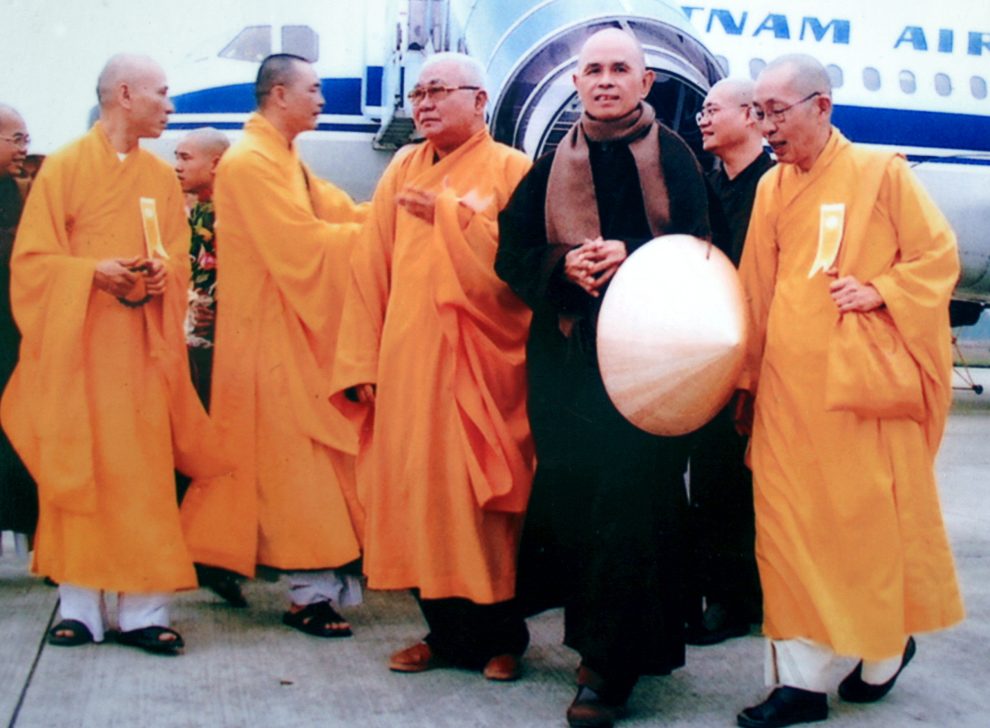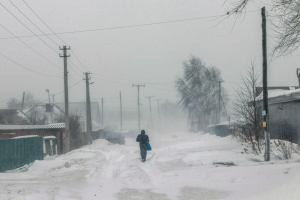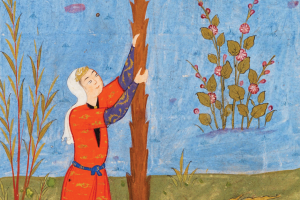The first thing you notice about Thich Nhat Hanh is that he walks really, really slowly. he also speaks very deliberately. And when he wants a sip of tea, he stops speaking, breathes in and out, takes a drink, lowers his cup, breathes again, and continues.
It’s called mindfulness—focusing completely on what you are doing in the present moment—and the renowned Vietnamese Buddhist monk believes this spiritual practice is the key to not only inner peace but global peace as well. Accustomed to being tagged naïve, he continues to promote peace through his writing, speaking, and retreats. During a trip to the United States last summer, he spoke to college students, police officers, and members of Congress.
Perhaps the second best-known Buddhist in America (after the Dalai Lama), Thich Nhat Hanh traces his lineage to the Buddha himself. A monk since 16, he first gained notoriety for his efforts toward reconciliation during the Vietnam War. He was nominated for the Nobel Peace Prize by Martin Luther King Jr. in 1967 and has written extensively about peace-most recently in Creating True Peace (Free Press, 2003). Now banned from his native country, he lives at Plum Village monastery in France, and at monastic centers he founded in Vermont and California.
Is it idealistic to be a pacifist in this day and age, with terrorists and suicide bombers? Is peace possible?
Peace is always possible, and it should begin with ourselves. All of us have feelings and emotions that make us suffer, but if we don’t do anything about them, we will make people around us suffer. But we can transform our own suffering and bring relief to ourselves, which will then allow us to be compassionate and gentle to others. Everybody can do it by practicing mindfulness or being in the present moment.
Individuals must learn how to bring the level of hatred and anger down in themselves and in their families so they can support our political leaders, who must do the same thing. Then, when we have enough compassion, we can help the other group of people we might have called enemies to do the same.
We all have wrong perceptions of ourselves and other people. From these wrong perceptions rise anger, hate, fear, and despair. These misperceptions are also the foundation of the willingness of terrorists to die for their cause. You cannot use bombs and shouting to help them see their own misperceptions. You have to use gentle communication. But you cannot practice gentle communication and compassion and listening if you don’t have peace within yourself. Our political leaders have been trained in political science; they have not been trained in these areas. That’s why spiritual leaders and others should help them.
What is an example of a wrong perception, and how could it be corrected?
Wrong perception is thinking that you are the only one who suffers. You think other people only make you suffer; they don’t suffer at all. For example, suppose you think the terrorists are only people who want to destroy and have no capacity to love, to understand. You think that you have done nothing to make them hate us like that. You are just victims of these people. That is wrong perception.
As humans, we are not perfect. We may have said or done things that may have given them the idea or the feeling that we want to destroy them as a civilization, as a religion, as a country. At least, maybe we have done or said something that has given them that perception.
So we have to ask them, “Have we done anything wrong? Have we tried to hurt you? We want to listen to you, to hear why you hate us so much and have done such a thing to us. Please tell us; help us to understand your suffering, your difficulty, your despair. If we understand, we may be able to refrain from doing or saying things that may make you suffer. We may be able to help you to live in peace and to grow as a people, as a nation.”
During this process of deep, compassionate listening, you are able to remove the wrong perception in yourself, and then you are able to help the other person remove their wrong perceptions. Wrong perceptions are the foundation of hate and violence. Our politicians would be able to do that kind of talking if they had enough understanding and compassion in them.
Do you think that approach has been tried by America, especially since September 11?
Some of us have voiced concern and protested against war, but we have not done things in a complete way to help our political leaders to calm down, to practice looking serenely into the present situation, and to act with more understanding and compassion.
We need to convince people that peace and safety are not individual matters. That is why to help others to be safe will help us to be safe. If you allow them to be alive, then you have a small chance to also be alive. That is the insight of “interbeing,” the interconnectedness of all living things.
Nothing can be accomplished alone; everything has to coexist with everything else. That is deep in the teaching of Buddhism, and also in the teaching of Christianity and Judaism. Anything that happens to the left hand also happens to the right hand. Anything the right hand does to help the left hand also helps the right hand. If we can touch that reality of interbeing, then we’ll be able to make brotherhood into a reality.
I think that there are enough Americans who are enlightened, who realize it’s wrong to deal with terrorism by responding with more violence. There are enough Americans who have enough compassion and understanding. They should organize and voice their wisdom very clearly to show the nation the path.
In the gospel it says when you have the light, you cannot hide it under a bushel basket. That is why we have to come together. We have to offer our light to the whole nation and to the government, to Congress.
Members of Congress need to bring peace into themselves and to listen to each other with compassion so that communication can be a reality. When communication is possible, then you can produce the collective wisdom and insight that will bring about peace for the nation and for the world.
I encourage Congress as a whole to meditate. To meditate means to have the time to be in the here and now and to practice looking deeply into our situation, into the nature of our suffering. Then out of that practice of looking deeply will come the collective insight that will be the best thing Congress can offer to the nation, to the people.
What else can people do to promote peace?
You have to promote peace education to help the people wake up to the fact that the path of violence does not work any longer. People who hate will create more terrorists and hate by using violence. This phrase “war on terror” is very misleading. I don’t know why people use language in such a way. War on terror means terror on terror. In the gospels we learn very clearly that hate cannot be responded to by hate. Violence cannot be responded to by violence.
The American people are deeply religious people. They have confidence in Jesus’ teaching and in God, yet their belief needs to be translated into practice. Right thinking goes along with compassion and understanding. If your thinking is categorized by hate and violence, that’s not right thinking.
Why do so many Americans believe otherwise, that violence is the only answer to terrorism?
I think because so many of us have not done our job. For example, educators don’t know how to deal with fear or anger within themselves so they didn’t know how to help their students to bring peace to themselves when September 11 happened.
The mass media, too, often encourage violence and hate. You can report a truth without sowing the seeds of fear, anger, and hatred in your readers. Instead you can sow the seed of compassion, understanding, and insight in them. The mass media can play a very important role in helping cultivate the positive emotions in us.
And our spiritual leaders have not taught the practices to respond to the situation of suffering and confusion, especially to younger people. This is true not only of Christianity but of judaism and Buddhism as well. We have to renew the teaching. We have to offer the kind of teaching that can respond to the actual suffering of the people.
If I were born a Catholic, I would promote the teaching of living the kingdom of God in the here and now. That is similar to Buddhism, in which the Pure Land of the Buddha is available in the here and now. You don’t need to wait until tomorrow to enjoy the kingdom of God.
That is the teaching I dispense to my students. You don’t need to die in order to go to the Pure Land of the Buddha. You don’t need to die in order to go to the kingdom of God, because it is said that God is available to us 24 hours a day and so is his kingdom.
So if you know how to live in the present moment and be happy, you don’t have to chase more fame, more profit, more power, more sex. So many people have plenty of fame and power and sex and wealth, yet they suffer very deeply. But those who live simply don’t need a lot of these things and are happy in the here and now.
In the Gospel of Saint Matthew it says don’t worry about tomorrow. Let tomorrow take care of itself. Care about today. That is very clear. It goes perfectly with the practice of mindfulness in Buddhism. Give us today our daily bread. Our daily bread is the joy, peace, understanding that is available, that is the kingdom of God.
But although the kingdom of God is available to you, often you are not available to the kingdom of God because you are so preoccupied with the future or with the past. That is why the practice of mindfulness is the practice of freedom. You free yourself from regret, from the concerns of the past. You free yourself from the uncertainty and the fear about the future. You go home to the present moment with freedom, and you step into the kingdom of God where you can live happily right here, right now. The kingdom of God is now or never. The Pure Land of the Buddha is now or never.
So you see Buddhism and Christianity as being compatible, working together toward peace?
Yes. The practice of mindfulness is non-sectarian. But there are many aspects of the Buddha’s teaching that can also be explored and developed in order to respond to the actual suffering of the world. This is true for Judaism and Christianity, too. I think we can go deeper into the teachings of the Resurrection and the notion of creation.
But we don’t want people in the West to get uprooted from their spiritual tradition. A tree with no root cannot be a happy tree. The practice of mindfulness is to help renew their own tradition. We don’t want to convert Christians into Buddhists. We want Christians to be happy Christians and practicing well. We have enough Buddhists—more than we can take care of!
You are a proponent of what you call “engaged Buddhism.” Why do you believe action and contemplation have to go together?
They do go together, because if you have compassion from practicing contemplation, that energy always wants to manifest itself. You cannot stay there without doing anything.
If you are sitting in a meditation hall and you hear bombs falling and children crying, you cannot continue to sit inside. You have to walk out and help. But you help in such a way that you can still maintain your breath.
Meditation is possible outside of the meditation hall. When you cook your breakfast, you can do meditation. When you drive your car, mindfulness is possible. When your telephone rings, meditation can be used. Don’t answer right away; smile and practice one breath in and one breath out to calm yourself. Going from one building to another, you can apply mindful walking. These things are very helpful.
It’s hard to organize our daily life so that the practice of peace is possible. But how we drive a car, cook our breakfast, do housework can bring peace into our heart and our mind.
If, as you say in your book, people contain both seeds of violence and of peace, how can they become peaceful rather than violent?
When a person gets sick, she should be brought to a place where she can get well. If the sickness you have is a lot of despair, violence, and anger and you continue to be in an environment where these sicknesses will be encouraged every day, you cannot be healed. That is why the first step—the most important step—is to create a living environment where we can feel safe, where our children will feel safe. This is crucial.
A safe environment means a place where the seeds of anger and fear and despair and violence will not be watered every day. Instead, the seeds of compassion, the seeds of goodness, the seeds of hope will be watered every day.
For example, in our monastery, we make sure that the space we live in feels safe. We set up our practice of mindfulness. We don’t read the news. We don’t watch the kind of television that waters the seeds of violence and despair. We had to create a kind of family where we can be well taken care of.
We have to be mindful about what we consume. When you have a conversation, that is consumption because the conversation may be full of toxins, may be full of anger and hatred and fear. If you listen to a conversation like that for one hour, it’s very toxic.
So protect yourself. Don’t listen to these kinds of things. Don’t watch television programs that water the seeds of fear and hatred. Watch only the programs that can reveal to you the beauty of life, the beauty of compassion and understanding.
You have to practice with a community. At the monastery, we are a kind of family, and everyone has a “second body” to take care of. I have to care for you. If you suffer, I have to be aware of that. If you have a problem or difficulty, I have to help you feel better.
We always do things together, not as individuals—retreats, public talks. It’s always done as community. It is not enough just to practice as an individual. We have to organize ourselves into communities to help support each other.
In your book you offer several practices for creating an environment where families can learn to practice peace. Are these really practical for modern families with children?
The family is like a piece of land where trees can grow. If the soil is not good, then how could the tree be good? For families we might not use the word meditation. We might say in a modern home there should be some place where you can sit down and practice calming yourself, breathing in and out and sitting quietly.
You could call it the breathing room. You have a room for everything—guest room, play room, dining room—but you don’t have a room for your peace or for your nervous system. So have a small place, a small room where there are only some flowers and a few cushions.
When you don’t feel well, you walk into that room, following your breath. You don’t say anything. You don’t do anything, because doing anything or saying anything when you are angry is not very good for you or for others.
Go to the breathing room and smile, closing the door behind you peacefully. Sit down on a cushion, saying, “Breathing in, I calm myself. Breathing out, I smile.” And then you are OK.
If parents know how to do that, children will do it and everyone can enjoy sitting there for five minutes and practicing mindfulness before going to school and to work.
On weekends the whole family can go for a walk using the techniques of walking meditation, focusing on their breathing while walking mindfully. These things are easy to do with a little bit of training, and that is the practice of peace. Every time there is one person in the family not being peaceful, the other people will know and come and help. The key is to help—not to correct and not to punish.
You don’t need to be Buddhist. When a mother sees that her son is not peaceful, she can invite him, saying, “My son, let’s go together to the breathing room and sit and practice peace together.” Together they sit and they breathe in and they breathe out.
So it’s as simple as breathing? Some people may find that hard to believe.
The breath is somehow the link between body and mind. In our daily life, our body may be here, but our mind wanders into the future or to our projects. So when you breathe mindfully, you’re bringing your mind back to your body and you become fully present. If your breathing becomes calm and harmonious, that harmony and that calm begin to penetrate into your body and your feelings.
I think Congress should do that before they open a session of discussion. I think President Bush and other members of the government have the seeds of understanding and peace and compassion in them. But they need good advisors. If their advisors know how to water these seeds, they will act in the name of peace for all of us.
Do you think America or the world is ready to hear that message now? Do you think there is a shift happening?
I think suffering plays an important role because it makes you confused. Sometimes we are too sure of our perceptions. But if you get confused, you have a chance to look deeply to get a different understanding of what is going on.
Then you can find your path. And if you know that you are on the right path, you will feel much better and then you can share your light, your peace, with other people.
This article appeared in the December 2003 issue of U.S. Catholic magazine (Vol. 68, No. 12, page 18).
Image: Public Domain













Add comment